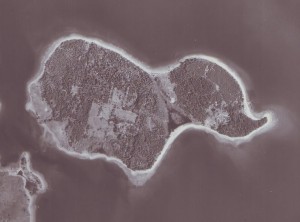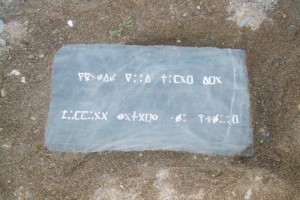
This is the original legend of how the Money Pit of Oak Island was discovered. It should not be taken as absolute fact, as many elements of the story have been debated and contested for the past century.
The discovery of the Oak Island Money Pit
In 1795 at age 16, Daniel McGinnis made his way across to Oak Island on a fishing expedition.
Once on the island, he found himself stood in a clearing in front of an old oak tree bearing the marks of unnatural scarring. This, he supposed to be caused by a rope and tackle system used to lower material down into a shaft below, indicated by a depression beneath the tree, about 4.8 meters in diameter. This completed the scene as one Daniel immediately recognised from childhood tales of swashbuckling pirates.
The very next day, Daniel McGinnis returned to Oak Island accompanied by two friends, Anthony Vaughan and John Smith. Equipped with picks and shovels they began the task of recover the treasure – but it was to take significantly more digging equipment than first anticipated.
As the three boys began to dig, they found the earth still bore pick marks on its smooth, clay sides. Their excitement rose when, at a depth of 1.2 metres they hit a layer of flagstones. These were removed only to reveal packed logs at 3 metre, 6 metre and 9 metre intervals.
On removing these layers of logs, the boys were quickly realised that they were going to need more substantial tools if they were going to recover the treasure of Oak Island. They reluctantly returned to the mainland, making a pledge to return and recover the treasure.
Although nine years were to pass until Daniel, Anthony and John were to return to Oak Island, they found the treasure digging site just as they had left it. Returning with Simeon Lynds, a local businessman, the project now had financial backing and significant support from they local labour force. The treasure excavation had now begun in earnest, with everyone in the syndicate working in return for a share of the gold if and when they found it.
As the treasure seekers dug deeper, more oak platforms were recovered at depths of 12 metres, 15.2 metres and at 18.2 metres, with the addition of coconut fibre and putty. At 21.3 metres, they hit a platform of plain oak, followed by more oak but sealed with putty at 24.4 metres.
Much to the syndicate’s excitement, at 27.4 metres, a stone, not native to Nova Scotia was recovered bearing an inscription. They believed they were about to recover a hoard of pirate’s treasure.

Sadly, the significance the illegible cypher on this stone was lost on Smith and the other treasure hunters as Smith, who owned the island at that time fitted the stone in his fireplace. The inscription was translated to read:
Forty Feet Below Two Million Pounds Are Buried
Believing the pirate treasure to lie beneath the mysterious stone, it was hastily removed from the pit to uncover another layer of wood, rather than the bounty of treasure the prospectors believed would surely lie beneath.
As nightfall descended, the party disbanded due to poor visibility and water becoming an increasing problem, the deeper they dug. All digging was aborted until daylight as it was thought the pirate riches could wait one more night in the ground, having been buried for any number of years already. They must have left the island with the thoughts of pirates and vast treasure filling their minds.
Sunday, being the next day, no work took place on the pit due to religious commitments. The group returned to Oak Island on Monday eager to recover treasure only to find the shaft flooded with seawater, all but 10 metres from the surface.
All excavation attempts to pump and bail out the water failed, resulting in the pit containing water at a constant level of 10 metres from the top. Digging became impossible in this situation and the project was abandoned for one year. All workers returned to their farms and looked forward to continuing the search in the springtime.
It was decided that a separate treasure shaft be dug next to the original in order to allow the flood water to pass into this new chamber. At a depth of 33.5 metres, the original shaft was tunnelled into but to no avail. The diggers were lucky to escape with their lives as the walls of the new shaft caved in, leaving the original shaft flooded up to a level of 10m below the surface again.
Smith began to despair in the syndicate’s misfortunes, believing they had been beaten by nature. He gave up, accepting the treasure to be out of their grasp, a feeling many were to experience in the future, even with the use of metal detectors and radar.